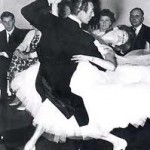By Barry Gasson
The tango stance
To create a broad idea as to an idealistic stance one must consider the feet being offset approximately 45 degrees to left of body alignment, as distinct from the foot/body alignment relationship in the standard Swing Dances. The word “obliqueness’ is often used but does not adequately express an exactitude of angle.
One must show the ‘Tango Legs. Sharply angled knees which typifies and characterizes the English style of Tango. One must bear in mind that the angled knees must not allow a ‘sitting’ position to be developed, there should be a feeling of length between the rib-cage and the knees, and the body held in the normal vertical position as it would be in the three swing dances. The vertical alignment of the shoulder and hip on one side of the body must be observed. The weight of the man at the start should be felt over the back part of the feet. The body poise should be forward with the diaphragm in a vertical line over the toe of the supporting foot. The shoulder blades will feel in a vertical line over the heel of the standing foot.

The leg lines would broadly resemble the shape of a straight sided martini glass, with the two thighs taking the shape of the sides of the glass, and the lower legs representing the central stem.
The obliqueness of the body to feet will result in the mans right arm being placed further around the Ladies back, with a slightly more enveloping hold, which, in turn, will influence the left arm of the man. This arm should have the forearm almost parallel to the floor with the wrist showing a broken line, and the angle of the elbow will show a more acute angle, rather than obtuse.
The lady’s left hand, instead of being poised on the man’s upper right arm, will be placed under the man’s upper right arm, and, depending on the length of the arm, even tucked into the man’s armpit. (Not a pretty Site!)
She will, at all times, remain with her body weight poised in the man’s right arm, no matter what figure is being performed. I want the Lady to feel that my right arm is rather like the back of a chair. It will not grip or hold the Lady, it remains passively available for her to use, if required. It is the
Man’s LEFT hand and arm that provide the control factor of the Dance.
Additionally, the Lady will be placed a little further to the man’s right side so that the man’s right foot is in line with Lady’s right foot. The feet will then form three tracks, instead of the four tracks that one finds in the normal stance.
There is a feeling that the Ladies body stance is the exact opposite to that of the man and her alignment is also the opposite.
I believe that the man does not want a clogging, cloying contact with partner, although there will be a greater spread of contact in Tango. However, I do not want to contact my Lady partner with the hips and legs. Never with the legs! He must not put a hip on the Lady in Tango dance position, he reserves that for the introduction of Promenade and Fallaway Positions.
I have heard it said that the man keeps his right hip on the Lady at all times. I believe this to be a complete fallacy. He touches the Lady in the diaphragm area, with a greater spread than the normal contact for the three swing Dances. But a large collision of bodies is undesirable. No man can move his Lady through high level movements requiring speed and agility with a clogging contact that creates weight and friction.
Because of the position of the feet in relation to the body, and the changes in the clasped hold, a walk on the left foot will curve to the left. It is taken in CBMP, and CBM must also occur. It is therefore evident that the weight will not move through the foot, from heel, ball toe as in the normal Dance technique, but rather across the foot from the outside of foot to the inside of foot, around the area of the toe-cap.
The walk on the right foot will follow the directional curve of the left foot walk. There is an important aspect to this walk that should be considered. The right leg and foot will not be carried under the right hip, rather the leg must move outside the line of the right hip.
The compression of the standing knee will determine the poise to project the body towards the Lady, and I always teach the Lady that she should instigate the turn, either by turning her right side towards me, or feeling that she turns her left side away from me, which sounds like the same thing, but everybody interprets instructions differently.
The feet are picked up, and placed into position without an extending or sliding heel lead. It must also be understood that the curving nature of two walks will tend to make the man form a left sway, if he lets it! Of course this would be disastrous. The man should feel that, through the production of the walks, his right shoulder should be lower than the left, and he will try to encourage the Lady to take her weight over the left foot, almost like commencing to dance a Right Lunge.
When I am Dancing Tango walks, I start with my left leg. I move my supporting right knee forward and downwards to project my body, lever the left leg into place, and change my weight smoothly on to the left foot and I have not touched either of the Lady’s hips. Then, having made the left foot strike, I walk through the left leg, flex the knee to move the body, let the right hip and shoulder move forward through the arc that has already been created by the angle of the body and the CBMP on the left leg and the slight CBM that I need. The Lady is moving smoothly away with her left hip and shoulder with her left leg moving into slight open position, and I am still not in contact with any one hip.
There should be no collision with legs or body, I do not push the Lady’s legs into place. The manner of movement of a good class couple will be such that the timing value of the standing leg, and the muscular feel between partners will create an automatic co-ordination. A good class Lady will be moving away on my action, so controlled and balanced as part of my action, that I will never touch her legs, and when she is coming forward she won’t hit mine.
Of course, there will be an occasional brush of limbs, this will often occur, but to design a contact with legs and/or hips is a horrible idea.
One must reiterate. There is no pushing operation on the part of the person going forward, in any dance!!!
Having performed two walks, I want to consider the placement of the right foot, in the Progressive Side Step, a Four Step, a Progressive Link etc.
I believe that the Right Foot lands in a downward direction, under its own hip, so that the Progressive Side Step can be performed unobtrusively without an obvious weight change that can be reflected in the upper body.
I believe that the second step of a Four Step will land under my hip, almost closed, so that my turn will move my right leg contact with Lady from the inside of the leg to the outside, so that her left hip does not become prominent, and we can maintain a more slender, tapered look.
When Dancing two Walks and a Progressive Link, I try to feel that my weight trajectory is such, that I am responsible for lowering her back heel on each of the two Walks. When I enter the Link I retard my weight, so that her heel does not lower. She will then reflex on my action, turn swiftly on the ball of her right foot, to move her left foot to a position of side and slightly back in Promenade Position. Furthermore, when training a Lady I tell her “I cannot turn you, you must turn yourself.”
Having danced the first step, my Right leg will move FORWARDS, until it almost closes, to a position of ‘Side and slightly back’. There must be no sideways movement on the part of the man. If he were to move sideways, he would inevitably dance a ‘Knockerova’ with his right hip. This goes right back to initial training and understanding of foot positions. The right foot will move forward until it reaches a position of side and slightly back in relation to the other foot.
This first step of the Progressive Link could be likened to a ‘Mini Contra Check’. Some men feel that the right side moves forward on the first step, others that the left side moves back. Either way, she turns on the ball of the right foot on my weight retardation and I follow her into the Link and take my right side back.
A further point of interest in this figure. Steps counted ‘quick’ are always in pairs, and it is customary for the Dancer to accent the first of a pair. Steps one and two of a Four Step, or one and two of a Reverse Turn. However in the Progressive Link the reverse would apply. I would recommend a feeling of placing the left and then moving with alacrity for the second. Which I translate as
‘Place—MOVE!!
Finally, one must overcome the desire to escalate above the initial height.
KEEP THE LID ON !!!
The common tendency for dancers to escalate is becoming more and more prevalent, mores the pity. Indeed, were it not for the characteristic head flicks, shakes and shrugs that identify the uniqueness of the Tango, the dance would look like any other dance that uses swing action and rise.
Barry Gasson









